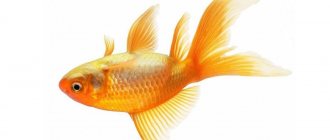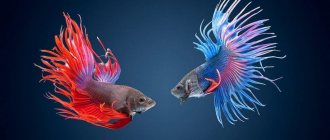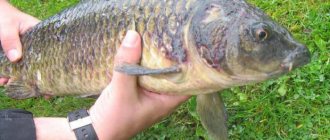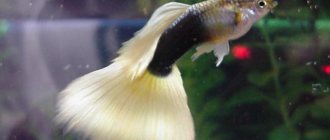Causes
If this behavior is not normal for a given fish, there may be several reasons.
- Loss of buoyancy or control of buoyancy. This is usually the result of swim bladder dysfunction. The fish can swim head or tail down, partially or completely on its side, or even belly up. This problem may indicate an injury or bacterial infection in the swim bladder. In addition, swim bladder dysfunction occurs in the later stages of certain diseases (for example, hydrops, bloat, fatty liver, general obesity, or a genetic problem. Loss of buoyancy control may be the result of destruction of the central nervous system due to another disease - for example, hypoxia , poisoning or brain tumor.If the fish is clearly suffering (for example, swimming with great difficulty) and after two or three days there are no signs of recovery, then the only humane option is euthanasia.
- If the fish is swimming upside down, this may indicate that there is a foreign body stuck in its mouth or throat (for example, a stone, a piece of equipment) or there is a large tumor there. The fish should be caught with a net and its mouth and throat examined. Soft and smooth foreign bodies can sometimes be removed with tweezers. Otherwise, veterinary assistance may be required.
- The fish may swim upside down or upside down, stand in the corners of the aquarium, or hide behind decorative objects in an attempt to avoid aggression. If you observe the aquarium closely, you will usually notice that one of the healthy fish clearly takes command of the entire aquarium and chases any other fish that dares to appear from its hiding place. The stress that victims experience is a serious threat to their health. This situation needs to be corrected as quickly as possible. To do this, it may be necessary to remove aggressive fish from the aquarium.
- If a fish swims head up or down when meeting a fish of higher status, it signifies respect and submission.
- Swimming upside down can mean stress for a variety of reasons.
- Fish with long fins - representatives of artificially bred vaul forms - sometimes swim with their heads slightly raised (or, more precisely, with their tails lowered), since their fins have significant weight.
- Fish suffering from hypoxia often swim or hover upside down near the surface of the water, where the oxygen content of the water is higher.
Turned white
Color change is a natural phenomenon for goldfish up to 2 years old. As the temperature drops, pets become paler. The color is also influenced by the shade of the primer; white primer leads to a natural lightening of the color. Strange behavior and paleness are caused by diseases and improper maintenance:
- Ichthyophthyriasis.
- Insufficiently nutritious food.
- "Cotton disease." The animal behaves restlessly, itches, and plaque or growths resembling cotton wool appear on the body. Eliminate sources of stress, check water parameters. Use products containing phenoxyethanol.
- Costiosis. Accompanied by loss of appetite, itching, and the appearance of a white or gray coating. Introduced with infected individuals and live food. Treat with copper sulfate (1 g per 10 l), place the goldfish in the solution for 10 minutes. Repeat the procedure for 5 days. Treatment with salt is acceptable. Immerse the goldfish in the bath (25 g per 10 l) for 15 minutes. in a week.
Video
5 NEW CRAFTS for FISHING
It's time to introduce taxes for such homemade products! Brilliant idea
Online lesson: “Pisces”
How to swim faster? 5 mistakes that prevent you from increasing your freestyle swimming speed
Max and his behavior
ZOO-portal EXOTICS
Add a comment
The tail is peeling
Damage to the tail indicates diseases:
- Fin rot. In goldfish, red veins appear, the edges become smaller, and the fins may turn black. Place the golden carp in a bath of salt water (1 teaspoon per 3 liters) for half an hour. Carry out the procedure once a day for a couple of weeks. The use of preparations based on malachite green and methylene blue is effective.
- Flexibacteriosis (columnaria). Appears in dirty and too warm water. The initial stage of the disease is treatable. In addition to discoloration of the tail with subsequent destruction, ruffling of the scales in the tail part, paleness of the edges of the scales, lightening of the mouth area and stiffness of movements are observed. Immerse the goldfish in baths with a pinkish solution of potassium permanganate for 10–15 minutes for 3–5 days. You can use chloramphenicol (50 mg per 3 l), adding it every other day for a week. After this, add kanamycin (1 g per 20 l) according to a similar scheme.
Neighbors' aggression
Before going to the store for new fish, you need to weigh the pros and cons, as well as the ability of the existing inhabitants to get along with the new “neighbors.” You don't need to rely on the seller's experience. Follow the fundamental rules:
- large inhabitants always try to devour small ones (this also applies to herbivorous species);
- a large number of fish are susceptible to aggression within species;
- some species attach themselves to small neighbors, which threatens death;
- the strong always consume the weak;
- Buy only those fish that have a peaceful character.
Unfortunately, it is very difficult to identify why fish die in an aquarium. Experienced aquarists also experience fish deaths. Treat the inhabitants attentively and then it will be easy for you to identify the cause of their illness.
The scales fall off and fall off
Goldfish scales fall off as a result of:
- Excess nitrites. Change the water and add conditioners.
- Neighborhood with catfish. Sticky catfish damage the scales. Sometimes the problem is solved by increasing the amount of plant food, but it is better to spread out the pets.
- Lepidorthosis. In certain areas of the body, scales rise and fall out. The disease is introduced with aquarium animals that have not undergone quarantine and soil from natural reservoirs. Treat carp with biomycin (1.4 g per 100 l), adding the solution weekly for a month. You can use baths with basic purple. Prepare a stock solution (100 mg per 1 liter), dilute 10–15 ml of the resulting solution in 10 liters of water. Place the sick individual in the solution for 4 days.
- Ichthyosporidiosis. Illness is indicated by intermittent swimming, convulsions, lying on the bottom on one side, heavy breathing, bulging eyes, loss of scales and bruising. The disease is difficult to cure. Dilute phenoxytol in water in a ratio of 1:100. Pour the resulting solution into the aquarium (10–20 ml of solution per 1 liter) for 2 weeks.
- Tuberculosis. In golden carps, a sign of mycobacteriosis is loss of scales without ruffling.
Prevention
Proper care and maintenance of goldfish is the main preventive measure. This will help exclude most acquired pathologies.
| Diseases | Prevention |
| gas formation, inflammatory processes of the intestinal tract, obesity | balance the diet - 70% plant foods, 30% protein |
| avoid overfeeding, arrange fasting days once a week | |
| Pre-soak dry food so that it does not swell in the intestines | |
| parasitic, infectious, bacterial diseases | deep freeze live food |
| add only healthy individuals to the aquarium after quarantine isolation | |
| hypoxia, toxic poisoning | provide fish with good aeration and filtration |
| select a tank of suitable volume to eliminate biological load | |
| control the physical parameters of water | |
| weekly siphon the bottom and replace 1/3 of the water volume | |
| gas embolism | normalize aeration |
| reduce the number of aquacultures | |
| foreign body in the intestine | exclude fine soil and other decorative elements that fish can swallow |
Particular attention should be paid to nutrition. It is recommended to use specialized combined feeds that are designed for this breed.
Die
Be responsible when cleaning your aquarium. You should know the water parameters and check it with tests. If your goldfish dies, immediately remove the deceased pet from the tank and inspect the other inhabitants of the aquarium. Before getting a fish, get acquainted with the features of starting a reservoir, feeding, compatibility and maintenance of the aquarium. Goldfish die for the following reasons:
- water pollution;
- unsuitable conditions;
- no quarantine for new fish;
- neglect of processing of feed and plants;
- overfeeding
Changing the temperature
If the fish lies on the bottom, this may be a sign of temperature shock, which occurs in most representatives of ornamental species when the temperature of the aquatic environment drops to +5°C and below. It is important to monitor temperature indicators, especially when introducing new individuals into the aquarium.
After the temperature increases, the fish will gradually come to its senses. However, subsequently, the stress experienced can negatively affect her health, provoking the development of infectious, autoimmune diseases, weakening of the immune system and the body’s own protective resources.
Growth on the head
There are breeds of goldfish with a “cap” on their heads (oranda, red cap, pearl with a crown). The growth appears at 3–4 months, sometimes unexpectedly for the aquarist. If you have a golden carp of another breed, the formation on the head is caused by:
- The appearance of a tumor. It cannot be treated, but under good conditions the animal will live a long time.
- Trauma.
- Unsuitable conditions.
Body shape, outer coverings
Body shape of fish
The body shape of fish is another adaptation to movement in dense water masses compared to air. The bodies of animals, except for benthic and deep-sea species, are spindle-shaped, streamlined, which create minimal resistance to the environment. In addition, do not forget about the scales, which increase gliding, reducing the energy expenditure of the animal during swimming.
Eyes bulging
Bulging eyes and the appearance of a whitish coating on the eyes accompanies the following diseases:
- ichthyosporidiosis;
- rubella;
- tuberculosis.
Examine the skin and fins, observe the behavior of the inhabitants of the aquarium. Check water parameters. Changes in one eye usually indicate injury.
Fins have turned black
Darkening of fins is caused by:
- Poisoning with nitrogenous compounds. The body is covered with black spots, the animal breathes rapidly and stays near the surface. Increase aeration and change up to 30% of the water. Adding conditioners that neutralize harmful compounds will help. Restart the aquarium. If there are few or no plants in the aquarium, plant them. The soil layer must be at least 5 cm.
- Fin rot.
Red spots
Causes of red spots:
- Rubella is a collective name for spring viremia of carp, aeromonosis, pseudomonosis and vibriosis - diseases with similar manifestations. Accompanied by hemorrhages, especially in the head area. Other signs: the appearance of ulcers, bulging eyes, swelling of the abdomen. Carry out treatment in a separate container. You will need leukocyte human interferon (1 ampoule per 35 l) in combination with chloramphenicol (2.5 g per 100 l). Apply every other day until the condition improves. Replace a third of the water at least 1-2 times a week. Chloramphenicol (250 mg per 25 g of feed) or furazolidone (0.5 g per 25 g of feed) also helps. Feed the mixture for 6 days. Provide continuous aeration during treatment.
- Skin and gill flukes. Animals behave restlessly, try to scratch themselves on objects, fins are often pressed, red spots appear on the body, and the skin becomes covered with mucus. Treat with special means against parasites or using baths with potassium permanganate.
- Ammonia poisoning.











